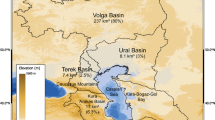Abstract
The Caspian Sea is the largest enclosed body of water on earth, covering approximately 4×105 km2 and sharing its coast with five countries (Iran, Azerbaijan, Kazakhstan, Russia and Turkmenistan). Because it has no outlet to the ocean the Caspian Sea level (CSL) has undergone rapid shifts in response to climatic forcings, and these have been devastating for the surrounding countries. In this paper we present the initial results of a modeling effort aimed at building a regional climate model for the Caspian Sea basin suitable to study the response of the CSL to interdecadal climate variability and anthropogenic climate change. Simulations are performed using the International Centre for Theoretical Physics (ICTP) regional climate model RegCM at a 50 km grid spacing for the period 1948–1990. During this period an abrupt shift occurred in the sea level after 1977, when the CSL rose about two meters until the early 1990s. Using a simple equation of hydrologic balance for the Caspian Sea basin to predict the CSL, we show that the model is able to reproduce the observed CSL changes at interannual to multidecadal scales. The correlation coefficient between the simulated and observed annual CSL changes is 0.91 and the model is able to reproduce the abrupt shift in CSL which occurred after 1977. Analysis of the climatologies before and after 1977 indicate that the CSL rise was mostly due to an increase in precipitation over the northern basin and a decrease in evaporation over the sea, primarily during the warm season. We plan to apply our model to the investigation of the response of the CSL to anthropogenic climate forcings.











Similar content being viewed by others
References
Adam J, Lettenmaier D (2003) Adjustment of global gridded precipitation for systematic bias. J Geophys Res 108:4257–4272
Arpe K, Bengtsson L, Golitsyn GS, Mokhov II, Semenov VA, Sporyshev PV (2000) Connection between caspian sea level variability and enso. Geophys Res Lett 27:2693–2696
Dickinson R, Henderson-Sellers A, Kennedy P(1993) Biosphere-atmosphere transfer scheme (bats) version 1e as coupled to the ncar community climate model. Technical report, National Center for Atmospheric Research
Evans J, Smith R, Oglesby R (2004) Middle east climate simulation and dominant precipitation processes. Int J Climatol 24:1671–1694
Folland C, Karl T, Christy J, Clarke R, Gruza G, Jouzel J, Mann M, Oerlermans J, Salinger M, Wang S (2001) Climate Change (2001) The Scientific Basis. In: Contribution of working group I to the third assessment report of the intergovernmental panel on climate change, chapter 2. Cambridge University Press, Cambridge, pp 99–181
Giorgi F, Shields C (1999) Tests of precipitation parameterizations available in the latest version of the ncar regional climate model (regcm) over the continental united states. J Geophys Res 104(D6):6353–6375
Giorgi F, Marinucci M, Bates G (1993a) Development of a second generation regional climate model (regcm2) i: boundary layer and radiative transfer processes. Mon Weather Rev 121:2794–2813
Giorgi F, Marinucci M, Bates G, DeCanio G (1993b) Development of a second generation regional climate model (regcm2) ii: convective processes and assimilation of lateral boundary conditions. Mon Weather Rev 121:2814–2832
Golitsyn G, Panin G (1989) The water balance and modern variations of the level of the caspian sea. Soviet Meteorol Hydrol, pp 46–52
Golitsyn G, Meleshko V, Meshcherskaya A, Mokhov I, Pavlova T, Galin V, Senatorsky A (1995) Gcm simulation of water balance over caspian sea and its watershed. In: Proceedings of the first international AMIP scientific conference, WMO/TD-No 732:15–19
Grell G (1993) Prognostic evaluation of assumptions used by cumulus parameterizations. Mon Weather Rev 121:764–787
Grell GA, Dudhia J, Stauffer DR (1994) A description of the fifth-generation penn state/ncar mesoscale model (mm5). In: Technical report NCAR/TN-398+STR, National Center for Atmospheric Research, nCAR Technical Note
Holtslag A, de Bruijn E, Pan HL (1990) A high resolution air mass transformation model for short-range weather forecasting. Mon Weather Rev 118:1561–1575
Kalnay E, Kanamitsu M, Kistler R, Collins W, Deaven D, Gandin L, Iredell M, Saha S, White G, Woollen J, Zhu Y, Chelliah M, Ebisuzaki W, Higgins W, Janowiak J, Mo K, Ropelewski C, Wang J, Leetmaa A, Reynolds R, Jenne R, Joseph D (1996) The ncep/ncar 40-year reanalysis project. Bull Am Meteorol Soc 77:437–471
Kiehl J, Hack J, Bonan G, Boville B, Breigleb B, Williamson D, Rasch P (1996) Description of the ncar community climate model (ccm3). Technical report NCAR/TN-420+STR, National Center for Atmospheric Research
Legates D, Willmott C (1990) Mean seasonal and spatial variability in gauge-corrected, global precipitation. Int J Climatol 10:111–127
Lydolph P (1977) Climates of the Soviet Union. Elsevier, Amsterdam
Mason I, Guzkowska M, Rapley C (1994) The response of lake levels and areas to climate change. Clim Change 27:161–197
New M, Lister D, Hulme M, Makin I (2002) A high-resolution data set of surface climate over global land areas. Clim Res 21:1–25
Pal J, Small E, Eltahir E (2000) Simulation of regional-scale water and energy budgets: representation of subgrid cloud and precipitation processes within regcm. J Geophys Res Atmos 105:29579–29594
Pal J, Giorgi F, Bi X (2004) Consistency of recent european summer precipitation trends and extremes with future regional climate projections. Geophys Res Lett 31:L13202. Doi 10.1029/2004GLO19836
Panin G, Divakov I (1991) Estimations of possible variations of evaporation from the north caspian sea under the conditions of sea level rising. Soviet Meteorol Hydrol (in press)
Rayner N, Parker D, Horton E, Folland C, Alexander L, Rowell D, Kent E, Kaplan A (2003) Global analyses of sea surface temperature, sea ice and night marine air temperature since the late nineteenth century. Journal of Geophysical Research 108(D14):ACL2.1–ACL2.29
Rodionov S (1994) Global and regional climate interaction: the Caspian Sea experience. Kluwer, Dordrecht
Acknowledgements
The authors would like to thank the anonymous reviewers for their suggestions which improved this paper.
Author information
Authors and Affiliations
Corresponding author
Rights and permissions
About this article
Cite this article
Elguindi, N., Giorgi, F. Simulating multi-decadal variability of Caspian Sea level changes using regional climate model outputs. Clim Dyn 26, 167–181 (2006). https://doi.org/10.1007/s00382-005-0077-5
Received:
Accepted:
Published:
Issue Date:
DOI: https://doi.org/10.1007/s00382-005-0077-5




